清华大学国际经济学-第二次个人作业
南大2016国际经济学第2次作业

作业名称国际经济学第二次作业作业总分100起止时间2016-11-2至2016-11-27 23:59:00通过分数60标准题总分100题号:1 题型:单选题(请在以下几个选项中选择唯一正确答案)本题分数:2如果一家美国公司从花旗银行墨西哥分行借入价值10亿美元的墨西哥比索,并用这笔钱在墨西哥建立了一家工厂,该交易在国际收支账户中的记账方式是()∙A、在短期私人资本流入中记为贷方,在直接投资支付中记为借方∙B、在长期私人资本流入中记为贷方,在长期私人资本流出中记为借方∙C、在长期私人资本流入中记为贷方,在直接投资中记为借方∙D、在短期私人资本流入中记为贷方,在短期私人资本流出中记为借方标准答案:a说明:题号:2 题型:单选题(请在以下几个选项中选择唯一正确答案)本题分数:2根据对外贸易乘数理论,在其他条件不变的条件下,边际进口倾向同对外贸易乘数值呈()∙A、反向关系∙B、无关联∙C、正向关系∙D、无法判断标准答案:a说明:题号:3 题型:单选题(请在以下几个选项中选择唯一正确答案)本题分数:2 我国公布的外汇牌价为100美元等于827.75元人民币,这种标价方法属于()∙A、直接标价法∙B、间接标价法∙C、美元标价法∙D、无法判断标准答案:a说明:题号:4 题型:单选题(请在以下几个选项中选择唯一正确答案)本题分数:2根据乘数原理,进出口数量的变化给国民收入带来的影响比进出口本身的数量要()∙A、一致∙B、大∙C、小∙D、无关标准答案:b说明:题号:5 题型:单选题(请在以下几个选项中选择唯一正确答案)本题分数:2 假定其他条件不变,一国的国民收入增加,容易导致国际收支出现()∙A、顺差∙B、逆差∙C、平衡∙D、无法判断标准答案:b说明:题号:6 题型:单选题(请在以下几个选项中选择唯一正确答案)本题分数:2 假定其他条件不变,一国处于经济的衰退期,则国际收支容易出现()∙A、顺差∙B、逆差∙C、平衡∙D、无法判断标准答案:a说明:题号:7 题型:单选题(请在以下几个选项中选择唯一正确答案)本题分数:2 根据IMF对国际收支的定义,“经济体”的含义比国家要()∙A、广∙B、窄∙C、二者相同∙D、二者无法比较标准答案:a说明:题号:8 题型:单选题(请在以下几个选项中选择唯一正确答案)本题分数:2 货币贬值之后贸易收支逆差并不能立即改善,原因不包括()∙A、认识时滞∙B、决策时滞∙C、生产时滞∙D、反应时滞标准答案:d说明:题号:9 题型:单选题(请在以下几个选项中选择唯一正确答案)本题分数:2 以下选项中,哪个选项不属于国际收支统计中居民的概念?∙A、外国企业∙B、非盈利机构∙C、国际经济组织∙D、政府标准答案:c说明:题号:10 题型:单选题(请在以下几个选项中选择唯一正确答案)本题分数:2 在国际收支平衡表中,下列不属于经常项目的是()∙A、商品贸易收支∙B、非货币用途的黄金贸易∙C、保险费和保险赔偿支付∙D、货币用途的黄金交易标准答案:d说明:题号:11 题型:单选题(请在以下几个选项中选择唯一正确答案)本题分数:2 编制国际收支平衡表所依据的原理是()∙A、收付实现制∙B、复式记账原理∙C、总分记账原理∙D、现金交易原理标准答案:b说明:题号:12 题型:单选题(请在以下几个选项中选择唯一正确答案)本题分数:2 IMF判断居民和非居民的标准是()∙A、国籍∙B、地理位置∙C、民族∙D、经济利益中心标准答案:d说明:题号:13 题型:单选题(请在以下几个选项中选择唯一正确答案)本题分数:2 经常项目账户上剩余为正,则()∙A、进口大于出口∙B、出口大于进口∙C、进、出口都变化∙D、进口和出口都相等标准答案:b说明:题号:14 题型:单选题(请在以下几个选项中选择唯一正确答案)本题分数:2 对外贸易乘数的理论基础是()∙A、国内价格乘数理论∙B、国内货币乘数理论∙C、国内投资乘数理论∙D、国内通货膨胀乘数理论标准答案:c说明:题号:15 题型:单选题(请在以下几个选项中选择唯一正确答案)本题分数:2狭义的国际收支是指()∙A、经常项目收支∙B、贸易收支∙C、外汇收支∙D、资本和金融项目收支标准答案:c说明:题号:16 题型:多选题(请在复选框中打勾,在以下几个选项中选择正确答案,答案可以是多个)本题分数:4本币贬值对经常项目收支的影响有()∙A、效率效应∙B、收入效应∙C、贸易量效应∙D、价格效应标准答案:cd说明:题号:17 题型:多选题(请在复选框中打勾,在以下几个选项中选择正确答案,答案可以是多个)本题分数:4有哪些因素会导致国际收支不平衡?∙A、经济周期∙B、结构失衡∙C、价格波动∙D、国民收入改变标准答案:abcd说明:题号:18 题型:多选题(请在复选框中打勾,在以下几个选项中选择正确答案,答案可以是多个)本题分数:4导致国际收支失衡的主要原因有()∙A、政治原因∙B、经济周期∙C、国民收入变化∙D、货币价值变动∙E、经济结构标准答案:bcde说明:题号:19 题型:多选题(请在复选框中打勾,在以下几个选项中选择正确答案,答案可以是多个)本题分数:4分析国际收支平衡表的方法有()∙A、动态分析∙B、静态分析∙C、比较动态分析∙D、多维分析∙E、比较分析标准答案:abe说明:题号:20 题型:多选题(请在复选框中打勾,在以下几个选项中选择正确答案,答案可以是多个)本题分数:4国际收支不平衡的类型有()∙A、周期性不平衡∙B、结构性不平衡∙C、货币性不平衡∙D、价格性不平衡∙E、收入性不平衡标准答案:abde说明:题号:21 题型:多选题(请在复选框中打勾,在以下几个选项中选择正确答案,答案可以是多个)本题分数:4影响经常项目的因素包括()∙A、汇率∙B、本国国民收入∙C、外国国民收入标准答案:abc说明:题号:22 题型:多选题(请在复选框中打勾,在以下几个选项中选择正确答案,答案可以是多个)本题分数:4非生产性非金融资产包括()∙A、无形资产∙B、知识产权∙C、专利权∙D、特许权标准答案:abcd说明:题号:23 题型:多选题(请在复选框中打勾,在以下几个选项中选择正确答案,答案可以是多个)本题分数:4外汇市场的功能包括()∙A、把资金和购买力从一个国家和一种货币转变到另一个国家和另一种货币∙B、信贷功能∙C、套期保值∙D、投机标准答案:abcd说明:题号:24 题型:多选题(请在复选框中打勾,在以下几个选项中选择正确答案,答案可以是多个)本题分数:4储备资产包括哪些()∙A、外汇∙B、黄金∙C、特别提款权(SDRS)∙D、在基金组织的储备头寸标准答案:abcd说明:题号:25 题型:多选题(请在复选框中打勾,在以下几个选项中选择正确答案,答案可以是多个)本题分数:4金融帐户包括()∙A、直接投资∙B、证券投资∙C、间接投资∙D、其他投资∙E、储备资产标准答案:abde说明:题号:26 题型:判断题本题分数:3直接标价是指用本国货币来衡量外国货币的价格,在该标价法下, 汇率数额的增加表示外国货币升值, 本国货币贬值。
国际经济学第二次作业..

作业名称:国际经济学第二次作业作业总分:100 通过分数:60起止时间:2015-5-4 至 2015-5-29 23:59:00标准题总分:100详细信息:题号:1 题型:单选题(请在以下几个选项中选择唯一正确答案)本题分数:2 内容:假设俄罗斯的年通货膨胀率为100%,而瑞士仅为5%。
根据相对购买力平价,瑞士法郎对俄罗斯卢布的汇率将为()A、下降95%B、上升95%C、上升5%D、下降5%正确答案:A题号:2 题型:单选题(请在以下几个选项中选择唯一正确答案)本题分数:2 内容:在政府货币政策保持不变,只采取紧缩的财政政策情况下,从内部需求看政府支出减少会导致()A、国民收入增加B、就业机会减少C、失业机会减少D、总需求增加正确答案:B题号:3 题型:单选题(请在以下几个选项中选择唯一正确答案)本题分数:2 内容:可以平滑连续地对国际收支失衡进行修正,并保持外汇市场经常处于平衡状态的汇率制度是()A、固定汇率制B、自由汇率制C、管理汇率制D、浮动汇率制正确答案:C题号:4 题型:单选题(请在以下几个选项中选择唯一正确答案)本题分数:2 内容:根据对外贸易乘数理论,在其他条件不变的条件下,边际消费倾向同对外贸易乘数值呈()A、反向关系B、无关联C、正向关系D、无法判断正确答案:C题号:5 题型:单选题(请在以下几个选项中选择唯一正确答案)本题分数:2 内容:可以通过汇率调整清楚地表示出一国国内各种商品价格高低的汇率制度是()A、固定汇率制B、自由汇率制C、管理汇率制D、浮动汇率制正确答案:C题号:6 题型:单选题(请在以下几个选项中选择唯一正确答案)本题分数:2 内容:以下选项中,哪个选项不属于国际收支统计中居民的概念?A、外国企业B、非盈利机构C、国际经济组织D、政府正确答案:C题号:7 题型:单选题(请在以下几个选项中选择唯一正确答案)本题分数:2 内容:()只能在期权到期日执行,既不能提前,也不能推后A、美式期权B、欧式期权C、看涨期权D、看跌期权正确答案:B题号:8 题型:单选题(请在以下几个选项中选择唯一正确答案)本题分数:2 内容:如下交易将在国际收支账户中被记为贷方的是()A、向外国人的支付B、得到外国人的支付C、外汇储备的减少D、既无价值流入,又无价值流出正确答案:B题号:9 题型:单选题(请在以下几个选项中选择唯一正确答案)本题分数:2 内容:下述几种货币中,哪一种是实行联合浮动的货币?A、英镑B、日元C、美元D、人民币正确答案:D题号:10 题型:单选题(请在以下几个选项中选择唯一正确答案)本题分数:2 内容:汇率根据银行买卖的角度划分不包括()A、买入汇率B、卖出汇率C、中间汇率D、基础汇率正确答案:D题号:11 题型:单选题(请在以下几个选项中选择唯一正确答案)本题分数:2 内容:居民在国外投资收益的汇回应该记入()A、经常帐户B、错误和遗漏帐户C、资本和金融帐户D、官方储备帐户正确答案:A题号:12 题型:单选题(请在以下几个选项中选择唯一正确答案)本题分数:2 内容:一般而言,实际利率的上升会引起()A、储蓄增加,投资减少B、储蓄增加,投资增加C、储蓄减少,投资减少D、储蓄减少,投资增加正确答案:A题号:13 题型:单选题(请在以下几个选项中选择唯一正确答案)本题分数:2 内容:下列采用间接标价法的国家是()A、英国B、中国C、日本D、法国正确答案:A题号:14 题型:单选题(请在以下几个选项中选择唯一正确答案)本题分数:2 内容:购买力平价理论的基础是()A、利率平价成立B、铸币平价成立C、一价定律成立D、汇兑心理说正确答案:C题号:15 题型:单选题(请在以下几个选项中选择唯一正确答案)本题分数:2 内容:资本抽逃是指()A、基于贬值恐慌的储备流失B、基于升值压力的储备流失正确答案:A题号:16 题型:多选题(请在复选框中打勾,在以下几个选项中选择正确答案,答案可以是多个)本题分数:4内容:下列关于一价定律和购买力平价的观点正确的是()A、购买力平价理论建立在一价定律的基础上B、一价定律的要求比购买力平价条件严格C、即使单个商品不满足一价定律,但购买力平价条件仍然可以成立正确答案:ABC题号:17 题型:多选题(请在复选框中打勾,在以下几个选项中选择正确答案,答案可以是多个)本题分数:4内容:按照政府是否干预,浮动汇率制可以分为()A、单独浮动B、清洁浮动C、管理浮动D、钉住浮动E、联合浮动正确答案:BC题号:18 题型:多选题(请在复选框中打勾,在以下几个选项中选择正确答案,答案可以是多个)本题分数:4内容:按照外汇收付的方式可以将汇率分为()A、即期汇率B、远期汇率C、电汇汇率D、信汇汇率E、票汇汇率正确答案:CDE题号:19 题型:多选题(请在复选框中打勾,在以下几个选项中选择正确答案,答案可以是多个)本题分数:4内容:宏观政策在实际运用中存在哪些问题()A、可能会引起长期的通货膨胀B、短期内,如果人们将扩张性政策与通货膨胀结合在一起,形成通货膨胀的合理预期,宏观经济政策即使在短期也不能刺激增长C、宏观政策效果的形成存在一定的时间滞后D、扩张性财政政策导致政府财政赤字E、扩张性财政政策下,易于产生贸易赤字,对汇率形成影响正确答案:ABCDE题号:20 题型:多选题(请在复选框中打勾,在以下几个选项中选择正确答案,答案可以是多个)本题分数:4内容:浮动汇率制按其浮动方式,可以分为()A、单独浮动B、清洁浮动C、管理浮动D、钉住浮动E、联合浮动正确答案:ADE题号:21 题型:多选题(请在复选框中打勾,在以下几个选项中选择正确答案,答案可以是多个)本题分数:4内容:导致国际收支失衡的主要原因有()A、政治原因B、经济周期C、国民收入变化D、货币价值变动E、经济结构正确答案:BCDE题号:22 题型:多选题(请在复选框中打勾,在以下几个选项中选择正确答案,答案可以是多个)本题分数:4内容:外汇干预对货币供给影响是()A、央行资产负债同时增加、国内货币供给增加B、央行资产负债不变、国内货币供给不变C、央行资产负债减少、国内货币供给减少D、央行资产负债不变、国内货币供给不变正确答案:ABCD题号:23 题型:多选题(请在复选框中打勾,在以下几个选项中选择正确答案,答案可以是多个)本题分数:4内容:影响名义汇率的因素()A、货币供给水平的变化B、货币供给增长率的变化C、产品需求结构的变化D、相对产品供给的变动正确答案:ABCD题号:24 题型:多选题(请在复选框中打勾,在以下几个选项中选择正确答案,答案可以是多个)本题分数:4内容:期货价格的特点是()A、预期性B、隐密性C、连续性D、权威性正确答案:ACD题号:25 题型:多选题(请在复选框中打勾,在以下几个选项中选择正确答案,答案可以是多个)本题分数:4内容:资产有哪些形式()A、工厂B、政府债券C、土地D、珍稀邮票正确答案:ABCD题号:26 题型:判断题本题分数:3内容:相对购买力平价理论认为,汇率的变动是由两国的通货膨胀率的差异决定的。
《国际经济学》篇章练习题及答案
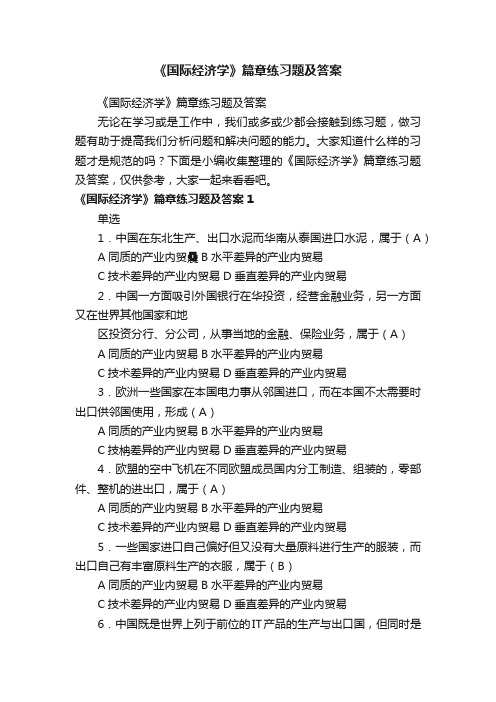
《国际经济学》篇章练习题及答案《国际经济学》篇章练习题及答案无论在学习或是工作中,我们或多或少都会接触到练习题,做习题有助于提高我们分析问题和解决问题的能力。
大家知道什么样的习题才是规范的吗?下面是小编收集整理的《国际经济学》篇章练习题及答案,仅供参考,大家一起来看看吧。
《国际经济学》篇章练习题及答案1单选1.中国在东北生产、出口水泥而华南从泰国进口水泥,属于(A)A同质的产业内贸曟B水平差异的产业内贸易C技术差异的产业内贸易D垂直差异的产业内贸易2.中国一方面吸引外国银行在华投资,经营金融业务,另一方面又在世界其他国家和地区投资分行、分公司,从事当地的金融、保险业务,属于(A)A同质的产业内贸易B水平差异的产业内贸易C技术差异的产业内贸易D垂直差异的产业内贸易3.欧洲一些国家在本国电力事从邻国进口,而在本国不太需要时出口供邻国使用,形成(A)A同质的产业内贸易B水平差异的产业内贸易C技柟差异的产业内贸易D垂直差异的产业内贸易4.欧盟的空中飞机在不同欧盟成员国内分工制造、组装的,零部件、整机的进出口,属于(A)A同质的产业内贸易B水平差异的产业内贸易C技术差异的产业内贸易D垂直差异的产业内贸易5.一些国家进口自己偏好但又没有大量原料进行生产的服装,而出口自己有丰富原料生产的衣服,属于(B)A同质的产业内贸易B水平差异的产业内贸易C技术差异的产业内贸易D垂直差异的产业内贸易6.中国既是世界上列于前位的IT产品的生产与出口国,但同时是高科技IT产品的进口国,属于(C)A同质的产业内贸易B水平差异的产业内贸易C技术差异的产业内贸易D垂直差异的产业内贸易7.发达国家在出口高档豪华车的同时,从其他发展中国家进口一些中、低质量的同类产品,属于(D)A同质的产业内贸易B水平差异的产业内贸易C技术差异的产业内贸易D垂直差异的产业内贸易8.新H-O模型解释的国际贸易类型是(D)A同质的产业内贸易B水平差异的产业内贸曟C技术差异的产业内贸易D垂直差异的产业内贸易9.克鲁格曼认为,产生产业内贸易的根本原因是(B)A差异产品的可选择性B规模经济C收入相似D经济发展水平相同10.林德需求重叠理论(B)。
清华大学国际经济学-第一次个人作业

2014年第一次国际经济学作业题目清单第一次作业说明:1)本题目清单中列示了各章的题目号,也列示了题目。
所列示的题目是根据各章中的题目号中的题目修改的,因此,大家根据题目清单中的题目回答问题就可。
列示题目号是方便大家寻找相应的教科书章节和原来的题目。
2)清单中,第二章到第九章共有14个题目,可以选择9个题目回答。
第十章中的8个题目任选2个即可。
3)大家在网络学堂提交作业,作业提交截止日期是:12月21日(周日)。
过时不再接受提交的作业。
国际经济学教材(机械工业出版社,Appleyard)第二章第2、3、9题1.什么是重商主义的思想支柱?为什么重商主义强调对经济要进行管制?解:重商主义的思想支柱是:(1)国际贸易总体来说是零和性质;(2)需要一个强大有力的政府进行市场干预;(3)劳动价值理论;(4)需要对经济活动进行调节,管控;(5)一个国家需要寻求贸易顺差对经济进行管制的原因是:重商主义者认为财富的唯一体现形式是贵金属的持有,经济活动和政策的目标应该是增加这些货币的持有,而一般的个体追求自己的利益难以实现这个目标,所以经济活动应该受到强烈的管制和干预。
2.重商主义悖论是什么意思?该悖论如何反映在重商主义的工资政策和人口政策方面?解:重商主义的悖论:(1)富有的国家有很多的穷人;(2)富有的国家要花费很多的财富来保护他们的财富。
体现在工资政策和人口政策方面主要是:为了减少劳动成本,工资被维持在一个很低的水平,而家庭却被鼓励生育孩子(通过税收和津贴的支持),这些现象导致了非常庞大的穷人阶层。
3. 近年来,中国保持了大量的贸易顺差,经济学家认为这种现象的持续是几种因素引起的,其中包括人民币的汇率水平。
重商主义如何解释这种盈余?为什么说大卫休谟认为这种盈余会自行消失?解:重商主义者如下解释这种盈余:重商主义者认为持续的贸易顺差是一件求之不得的事情,因为它产生了一中财富的净增长,对于重商主义者而言,贸易顺差代表着国家经济政策的成功,而不是一个问题。
北语22秋《国际经济学》作业2-学习答案

北语22秋《国际经济学》作业2
试卷总分:100 得分:100
一、单选题 (共 10 道试题,共 50 分)
1.下列不属于浮动汇率制度类型的是()。
[A.选项]可调整的固定汇率制度
[B.选项]有管理的浮动汇率制度
[C.选项]单独浮动汇率制度
[D.选项]联合浮动汇率制度
本题参考选择是:A
2.下列不属于贸易保护理论的有( )。
[A.选项]幼稚产业理论
[B.选项]贸易条件恶化论
[C.选项]国内市场失灵论
[D.选项]要素禀赋理论
本题参考选择是:D
3.随着各国收入水平的提高,国际贸易有利于制成品生产国,而不利于农产品特别是食品的生产国,在这里起作用的规律是()。
[A.选项]恩格尔定理
[B.选项]示范效应
[C.选项]大宗产品贸易理论
[D.选项]剩余物资出口理论
本题参考选择是:A
4.进口配额可以分为很多类型,最主要的两大类为()。
[A.选项]绝对配额和关税配额
[B.选项]全球配额和国别配额
[C.选项]自主配额和协议配额
[D.选项]自动配额和非自动配额
本题参考选择是:B
5.世界贸易组织成立于()。
[A.选项]1947年1月1日
[B.选项]1949年1月1日
[C.选项]1995年1月1日
[D.选项]1998年1月1日
本题参考选择是:C
6.根据国际收支调节的吸收分析法,若出现国际收支逆差,则应()。
[A.选项]提高国民收入和国民吸收
[B.选项]提高国民收入,减少国民吸收
[C.选项]减少国民收入,增加国民吸收
[D.选项]减少国民收入和国民吸收。
XXX《国际经济学》在线作业二15秋100分答案
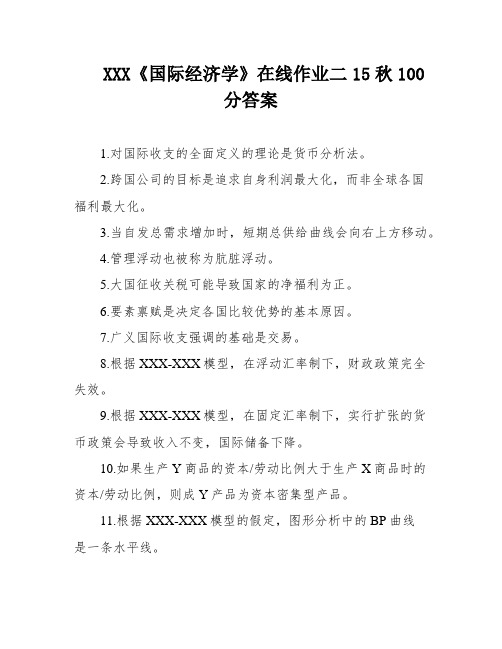
XXX《国际经济学》在线作业二15秋100分答案1.对国际收支的全面定义的理论是货币分析法。
2.跨国公司的目标是追求自身利润最大化,而非全球各国福利最大化。
3.当自发总需求增加时,短期总供给曲线会向右上方移动。
4.管理浮动也被称为肮脏浮动。
5.大国征收关税可能导致国家的净福利为正。
6.要素禀赋是决定各国比较优势的基本原因。
7.广义国际收支强调的基础是交易。
8.根据XXX-XXX模型,在浮动汇率制下,财政政策完全失效。
9.根据XXX-XXX模型,在固定汇率制下,实行扩张的货币政策会导致收入不变,国际储备下降。
10.如果生产Y商品的资本/劳动比例大于生产X商品时的资本/劳动比例,则成Y产品为资本密集型产品。
11.根据XXX-XXX模型的假定,图形分析中的BP曲线是一条水平线。
12.根据相互需求原理,决定两国产品交换实际比例的关键因素是两国的相对需求强度。
13.根据对外贸易乘数理论,在其他条件不变的条件下,边际消费倾向同对外贸易乘数值呈正向关系。
14.XXX-俄模型研究的是贸易的利益分配。
二、多选题(共10道试题,共40分。
)1.按照一体化的程度高低,国际经济一体化一般有下列形式:A.优惠贸易安排B.自由贸易区C.关税同盟D.共同市场E.经济联盟。
2.进口配额的主要形式有:A.相对配额 B.绝对配额 C.国别配额 D.全球配额 E.关税配额。
3.根据IMF的标准格式,国际收支平衡表的组成部分包括:A.经常帐户B.错误和遗漏帐户C.资本和金融帐户D.官方储备帐户 E.特别提款权帐户。
4.长期资本一般包括:A.直接投资 B.间接投资 C.国际信贷 D.游资 E.外贸信贷。
5.比较优势理论假定:A.所有劳动都是同质的 B.两国实行自由贸易 C.规模收益不变 D.国际经济是静态的 E.只有一种生产要素。
6.购买力平价理论的缺陷在于:A.没有考虑资本流动 B.没有考虑非贸易商品 C.没有考虑运输成本 D.没有考虑贸易障碍E.没有考虑产业结构。
高等教育出版社 《国际经济学》第二版 课后答案
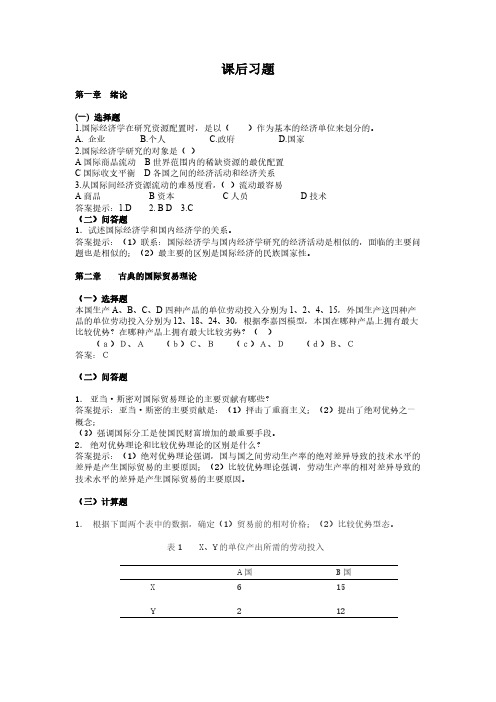
课后习题第一章绪论(一) 选择题1.国际经济学在研究资源配置时,是以()作为基本的经济单位来划分的。
A. 企业B.个人C.政府D.国家2.国际经济学研究的对象是()A国际商品流动B世界范围内的稀缺资源的最优配置C国际收支平衡D各国之间的经济活动和经济关系3.从国际间经济资源流动的难易度看,()流动最容易A商品B资本C人员D技术答案提示:1.D 2. B D 3.C(二)问答题1.试述国际经济学和国内经济学的关系。
答案提示:(1)联系:国际经济学与国内经济学研究的经济活动是相似的,面临的主要问题也是相似的;(2)最主要的区别是国际经济的民族国家性。
第二章古典的国际贸易理论(一)选择题本国生产A、B、C、D四种产品的单位劳动投入分别为1、2、4、15,外国生产这四种产品的单位劳动投入分别为12、18、24、30,根据李嘉图模型,本国在哪种产品上拥有最大比较优势?在哪种产品上拥有最大比较劣势?( )(a)D、A (b)C、B (c)A、D (d)B、C答案:C (二)问答题1.亚当·斯密对国际贸易理论的主要贡献有哪些?答案提示:亚当·斯密的主要贡献是:(1)抨击了重商主义;(2)提出了绝对优势之一概念;(3)强调国际分工是使国民财富增加的最重要手段。
2.绝对优势理论和比较优势理论的区别是什么?答案提示:(1)绝对优势理论强调,国与国之间劳动生产率的绝对差异导致的技术水平的差异是产生国际贸易的主要原因;(2)比较优势理论强调,劳动生产率的相对差异导致的技术水平的差异是产生国际贸易的主要原因。
(三)计算题1.根据下面两个表中的数据,确定(1)贸易前的相对价格;(2)比较优势型态。
表1 X、Y的单位产出所需的劳动投入A国 B国X Y 621512表2 X、Y的单位产出所需的劳动投入 A国 B国X Y 10455答案提示:首先将劳动投入转化为劳动生产率,然后应用与本章正文中一样的方法进行比较。
国际经济学作业答案-第二章
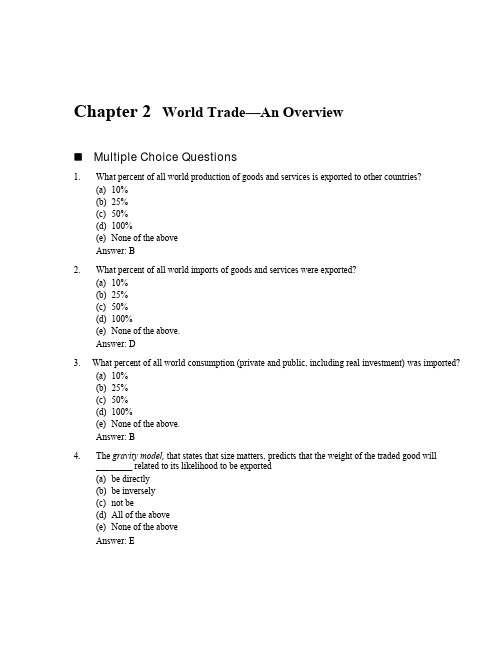
Chapter 2 World Trade—An OverviewMultiple Choice Questions1. What percent of all world production of goods and services is exported to other countries?(a) 10%(b) 25%(c) 50%(d) 100%(e) None of the aboveAnswer: B2.What percent of all world imports of goods and services were exported?(a) 10%(b) 25%(c) 50%(d) 100%(e) None of the above.Answer: D3. What percent of all world consumption (private and public, including real investment) was imported?(a) 10%(b) 25%(c) 50%(d) 100%(e) None of the above.Answer: B4. The gravity model, that states that size matters,predicts that the weight of the traded good will________ related to its likelihood to be exported(a) be directly(b) be inversely(c) not be(d) All of the above(e) None of the aboveAnswer: E12 Krugman/Obstfeld •Seventh Edition5. The gravity model offers a logical explanation for the fact that(a) Trade between Asia and the U.S. has grown faster than NAFTA trade.(b) Trade in services has grown faster than trade in goods.(c) Trade in manufactures has grown faster than in agricultural products(d) Intra-European Union trade exceeds International Trade of the European Union.(e) None of the aboveAnswer: D6. The gravity model suggests that over time(a) trade between neighboring countries will increase(b) trade between all countries will increase(c) world trade will eventually be swallowed by a black hole.(d) trade between Earth and other planets will become important(e) None of the aboveAnswer: E7. The gravity model explains why(a) trade between Sweden and Germany exceeds that between Sweden and Spain(b) countries with oil reserves tend to export oil.(c) capital rich countries export capital intensive products(d) intra-industry trade is relatively more important than other forms of trade between neighboringcountries.(e) None of the aboveAnswer: A8. According to the gravity model, a characteristic that tends to affect the probability of trade existingbetween any two countries is(a) their cultural affinity(b) the average weight/value of their traded goods(c) their colonial—historical ties(d) the distance between them(e) the number of varieties produced on the average by their industries.Answer: D9. The one single trade partner country of the U.S. is(a) United Kingdom(b) Canada(c) Mexico(d) Japan(e) IsraelAnswer: BChapter 2 World Trade—An Overview 13 10. In general which of the following tend to promote the probability of trade volumes between twocountries(a) Linguistic and/or cultural affinity(b) Historical ties(c) Sizes of economies(d) Mutual membership in preferential trade agreements(e) All of the aboveAnswer: E11. Since World War II (the early 1950s), the proportion of most countries’ production being used insome other country(a) remained constant(b) increased(c) decreased(d) fluctuated widely with no clear trend(e) both (a) and (d) aboveAnswer: B12. Since World War II, the likelihood that foreign markets would gain importance in the averageexporters’ as a source of profits(a) remained constant(b) increased(c) decreased(d) fluctuated widely with no clear trend(e) both (a) and (d) aboveAnswer: B13. Since World War II, the likelihood that any single item in the typical consumption basket of aconsumer in the U.S. originated outside of the U.S.(a) remained constant(b) increased(c) decreased(d) fluctuated widely with no clear trend(e) both (a) and (d) aboveAnswer: B14. Since World War II, the likelihood that the job a new college graduate will be directly or indirectlyaffected by world trade(a) remained constant(b) increased(c) decreased(d) fluctuated widely with no clear trend(e) both (a) and (d) aboveAnswer: B14 Krugman/Obstfeld •Seventh Edition15. Since World War II, the relative importance of raw materials, including oil, in total world trade(a) remained constant(b) increased(c) decreased(d) fluctuated widely with no clear trend(e) both (a) and (d) aboveAnswer: C16. In the current Post-Industrial economy, international trade in services (including banking andfinancial services)(a) dominates world trade(b) does not exist(c) is relatively small(d) is relatively stagnant(e) None of the aboveAnswer: C17. In the pre-World War I period, the U.S. exported primarily(a) manufactured goods(b) services(c) primary products including agricultural(d) technology intensive products(e) None of the aboveAnswer: C18. In the pre-World War I period, the United Kingdom exported primarily(a) manufactured goods(b) services(c) primary products including agricultural(d) technology intensive products(e) None of the aboveAnswer: A19. In the pre-World War I period, the United Kingdom imported primarily(a) manufactured goods(b) services(c) primary products including agricultural(d) technology intensive products(e) None of the aboveAnswer: CChapter 2 World Trade—An Overview 1520. In the present, most of the exports from China are in(a) manufactured goods(b) services(c) primary products including agricultural(d) technology intensive products(e) None of the aboveAnswer: A21. Which of the following does not explain the extent of trade between Ireland and the U.S.?(a) Historical ties(b) Cultural Linguistic ties(c) Gravity model(d) Multinational Corporations(e) None of the aboveAnswer: CEssay Questions1. When comparing the composition of world trade in the early 20th Century to the early 21st Century,we find major compositional changes. These include a relative decline in agricultural and primary-products (including raw materials). How would you explain this in terms of broad historicaldevelopments during this period?Answer: The typical composition of world production during this period experienced major changes. Focusing on today’s Industrialized Countries (primarily members of the O ECD),the industrial-employment composition was focused primarily on agriculture. Most valuewas in land. The predominant single consumption category was food. Since then, theeconomies shifted from the agricultural to the manufacturing sectors (continuing trendsbegun over a century earlier in the industrial revolution). Incomes rose, and consumptionshifted in favor of (increasingly affordable) manufactures. Both income and priceelasticities were greater in manufactures than in agricultural products. At the same timethere was a steady tendency for synthetic (manufactured) inputs to replace agriculturalbased raw materials and industrial inputs. Hence, trade and of course international tradeconformed to overall changes in patterns of world production and consumption.2. In the past half century, the developing countries have experienced major compositional shifts fromexports of primary products (including agricultural and raw materials) to exports of manufactures.How might you explain this in terms of broad historical developments during this period?16 Krugman/Obstfeld •Seventh EditionAnswer: Any discussion of the export experience of the developing countries must first clarify the problem of definitional inclusion. In particular, the exports of the (non-OECD) developingcountries, has become increasingly dominated by the experience of a relatively smallnumber of countries in South-East Asia, termed the New Industrialized Countries (NICs).Since they experienced both very rapid increases in their exports, and very rapid increasesin the manufactured component of their exports, their experience alone may explain thebulk of the observed phenomenon. Many would exclude the NICs from the developingcountry category so as to be able to focus the discussion on a more representative sampleof (the over 100) developing countries. More recently, a second wave of East Asiancountries, notably including China have replicated the experience of the NICs, and thisagain muddies the water for one interested in focusing on the export experience of thegrowing heterogenous category, developing countries.Chapter 2 World Trade—An Overview 17 Another explanation of the growing dependence on manufactured exports on the part ofthe developing countries, follows the answer to question 1 above. Since the consumer( including industrial consumer) markets in OECD countries were rapidly shifting awayfrom primary products, these markets were rapidly disappearing.In addition, in the world markets for primary products was generally limited by low priceand especially income elasticities; agricultural sectors tended to be highly and rigidlyprotected in potential OECD markets; and escalating effective tariff structures leviedsystematically large levels of protection against the primary exports of the developingcountries; success in world exports had to be pursued outside of the traditional primaryexports of these countries.3. The Neoclassical Heckscher-Ohlin model assumes that all producers of any industrial product hasknowledge of, and may avail itself of the same production technology available to producers in any other country. Many have flagged this identical technology assumption as an unrealistic assumption.During the past half century, the relative importance of the Multinational Corporations (MNCs) in world trade has steadily increased. How w ould this trend affect the realism of the “identicaltechnology” assumption?Answer: Noting that MNC plants tend to use more labor intensive production processes in countries where labor tends to be relatively cheap (both in “low” tech , e.g. Nike, and“high tech,” e.g. Motorola), one may argue that MNCs use different technologies indeveloping countries. However, this is a gross misunderstanding of the identicaltechnology assumption . It is axiomatically obvious that if the same MNC is producingsomething in both labor abundant and labor scarce using different processes, itnevertheless has knowledge (intimate knowledge in the case of proprietary patentedprocesses) of available technology. The fact that the MNC may choose not to apply thesame degree of capital intensity in environments with greatly different relative factorprices in no way lessens the fact that the Heckscher-Ohlin identical technologyassumption is strengthened due to the growing relative strength of MNCs in developingcountries. An additional fact that strengthens this argument is that, as compared to theearly 1950s, a growing proportion of MNCs are themselves based in developing countries,such as China and Brazil.4. One of the major political developments of the past several decades is the growing size andeconomic/monetary integration of the European Union. What effect do you think this will have on international trade between countries?Answer: The growing economic integration between the various countries of Europe, both the old and existing members of the European Union (EU) and the new countries joining it(including perhaps soon, Turkey), means that the barriers to trade are steadily falling in aregion that has traditionally dominated world trade. The common monetary unit should initself go far to promote inter-country trade within the growing EU (judging by thepositive historical effect of a single currency in the U.S.). The standardization oftransportation (including railroad gauges, highway signs etc.) and product codes will alsopromote expansion of intra-EU trade. The decline in the probability of political conflictassociated with this comprehensive economic union, plus conscious attempts to cooperatein fiscal and monetary policy stances again point to growing international trade, allowingthese countries to increasingly enjoy the fruits of potential positive scale economies, andmore traditional classical and neo-classical gains from trade. The scale economies willalso tend to increase trade between the EU and other countries.18 Krugman/Obstfeld •Seventh Edition5. The Services sector has been steadily rising in relative importance in GDP of the United States, aswell as elsewhere around the world. Since “services” have been identified as “non-tradables” (e.g. it is difficult to export haircuts), it may be argued that this trend will likely slow the rapid growth in international trade. Discuss.Answer: This argument stands on questionable logical foundations. The past half century has seena steady growth in the absolute and relative importance of international trade. This trendhas been reversed only by global conflicts, i.e. the two World Wars. This trend hasremained steady and robust despite major compositional shifts (e.g. from primary tomanufacturing), and location shifts (e.g., the sudden rise of NICs as significant group ofexporters). The trend will probably continue into the reasonable future, fueled by bothsuper-regional preferential trade regions and a growing impact of the multilateral forces,represented institutionally by the World Trade Organization (WTO)—as illustrated by therecent abolishment of the epitome cartelized trade, the world trade in textiles. Driven bytechnology—especially in the areas of communication and transportation—a reversal ofthe growing trade trend is not likely in t he near future. In any case, many “services” are infact quite tradable. Examples would be financial services, long-distance teaching, “help-desk” outsourcing, consulting and management services and others. In fact, when a touristgets a haircut, we s ee that even haircuts become a “tradable” service.。
清华大学国际经济学期末考试试卷

精品文档中央财经大学《国际经济学》期末试卷(C卷)一、单项选择题(下列各题的四个选项中,只有一个是正确的,多选、错选均不得分,每题1分,共10分)1. 本国生产甲、乙、丙、丁四种产品的单位劳动投入分别为1、2、4、15,外国生产这四种产品的单位劳动投入分别为12、18、24、30,根据李嘉图模型,本国在哪种产品上拥有最大比较优势?在哪种产品上拥有最大比较劣势?()A.丁、甲 B.丙、乙C.甲、丁D.乙、丙2. 从需求角度解释国际贸易产生原因的理论是()A. 产业内贸易说B. 技术差距说C. 人力资本说D. 偏好相似说3. 与从价税相比,从量税()A. 在商品价格上涨时保护作用更强B. 在商品价格下降时保护作用更强C. 能够体现公平税负原则D. 目前被大多数国家采用4.《洛美协定》所规定的欧盟对参加协定的发展中国家所提供的进口关税是()B. 差价税A. 普惠税特惠税最惠国税C.D.)5. 买方信贷是指(出口方银行向本国出口商提供的贷款A.出口方银行向外国进口商提供的贷款B.C. 进口方银行向外国出口商提供的贷款D. 进口方银行向本国进口商提供的贷款( ) 6. 在国际卡特尔订价中,当产品的需求弹性越小,卡特尔订价水平就B.越高 A.越低不确定不变C. D.( )国际生产折衷理论可以集中概括为下列优势的有机结合7.A.所有权优势、区位优势和技术优势B.所有权优势、内部化优势和技术优势C.区位优势、内部化优势和技术优势所有权优势、内部化优势和区位优势D. ( )8. 下述哪一种不属于投机性外汇交易 B.A.双边套汇多边套汇精品文档.精品文档C.套利D.套期保值9. 如果即期汇率为1英镑=2美元,六个月远期汇率为1英镑=1.96美元,则()A. 英镑年升税率2%B. 美元年升税率2%C. 英镑年贴税率4%D. 美元年贴税率4%10. 本国居民购买了外国公司的股票,该项在国际收支平衡表中的借方记为()A. 短期资本流入B. 短期资本流出C. 长期资本流入D. 长期资本流出二、多项选择题(下列各题所给的五个选项中,至少有一项以上的答案是正确的,多选、少选、错选均不得分,每题2分,共10分)1.假定食品部门与制造业部门的特定要素分别为土地与资本,两部门共同要素为劳动力,如果食品价格下降8%,下列哪些叙述是正确的?()A.工资率下降幅度小于8%B.食品部门产量下降、制造业部门产量上升C.资本所有者收入上升、土地所有者收入下降D.劳动力从食品部门流向制造业部门E.劳动力从制造业部门流向食品部门2.下列属于非关税壁垒措施的有()A.最惠国待遇B. 对外贸易的国家垄断C. 进口许可证D.技术和卫生检疫标准E. 自愿出口限制3.劳动力的国际流动对流入国带来的利益表现为()A.增加该国的财政收入 B.增加该国的国民财富C.增加该国的人才资源 D.增加该国的管理费用E.增加该国居民的就业岗位4.基本项目收支差额包括()A.商品贸易收支B.服务贸易收支C.资本项目收支D.官方结算收支E.金融资产变动项目收支5.一国在实现外部平衡的过程中,可供选择的政策措施有()A.融通资金B.外汇管制C.汇率浮动D.调整经济E.限制进口精品文档.精品文档三、判断题(下列各题,如果你认为描述正确请划“√”,如果认为错误请划“×”,每题1分,共10分)()1.一国对贸易商品的供求弹性越大,供求曲线越陡峭,该国从建立关税同盟中获得的贸易创造利益就越大。
国际经济学2 的习题43页PPT

56、书不仅是生活,而且是现在、过 去和未 来文化 生活的 源泉。 ——库 法耶夫 57、生命不可能有两次,但许多人连一 次也不 善于度 过。— —吕凯 特 58、问渠哪得清如许,为有源头活水来 。—— 朱熹 59、我的努力求学没有得到别的好处, 只不过 是愈来 愈发觉 自敢地 走到底 ,决不 回头。 ——左
国际经济学2 的习题
16、自己选择的路、跪着也要把它走 完。 17、一般情况下)不想三年以后的事, 只想现 在的事 。现在 有成就 ,以后 才能更 辉煌。
18、敢于向黑暗宣战的人,心里必须 充满光 明。 19、学习的关键--重复。
20、懦弱的人只会裹足不前,莽撞的 人只能 引为烧 身,只 有真正 勇敢的 人才能 所向披 靡。
第二次国际经济学作业及答案

1.分别说明以下各图对应的是什么情况,并加以解释。
这种情况称为需求的逆转,也即是需求的差异超过了供给能力方面的差异,即有生产劳动密集型产品供给优势的国家也更加偏爱劳动密集型商品,导致其劳动密集型商品对资本密集型商品的价格反而比另外一个国家(资本充裕的国家)更高,开放贸易后反而进口劳动密集型商品,对于另一国也是一样的情况。
3.过去20年在美国以及一些其他发达国家,国际贸易对工资不平等的加剧是否起到什么作用?应怎样解释?
过去20年,美国与发展中国家,尤其是新兴工业化国家的国际贸易加剧了国内熟练工人与不熟练工人之间的工资不平等。
首先,对劳动密集型商品进口的增加减少了对不熟练工人的需求;其次,劳动节约型的变革的加速引进进一步减少了对不熟练工人的需求。
然而,国际贸易只是导致美国国内工资不平等加剧的一小部分原因,最重要的原因是技术变革。
4.根据教材中运输成本与国际贸易的模型图,说明对贸易商品的供求曲线较陡峭的国家,负担的运输成本较大。
(画图并加以说明)
5.完全竞争厂商、垄断竞争厂商和完全垄断厂商所面临的需求曲线之间有什么差异?为什么?
6.画一张与教材中规模经济国际贸易模型图相似的图,表示在规模经济下,生产可能性曲线相同而偏好不同的国家之间是如何互利贸易的。
7.根据产业内贸易指数,计算下列进出口水平下,产业内贸易的程度。
(1)1000(出口)和1000(进口)下同
(2)1000和750
(3)1000和500
(4)1000和250
(5)1000和0
这些大家可以根据公式自行计算。
国际经济学作业international economics (Assignment)
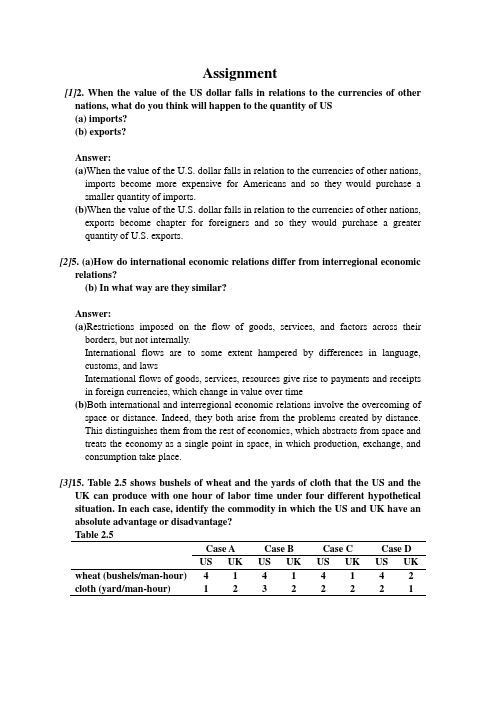
Assignment[1]2. When the value of the US dollar falls in relations to the currencies of othernations, what do you think will happen to the quantity of US(a) imports?(b) exports?Answer:(a)When the value of the U.S. dollar falls in relation to the currencies of other nations,imports become more expensive for Americans and so they would purchase a smaller quantity of imports.(b)When the value of the U.S. dollar falls in relation to the currencies of other nations,exports become chapter for foreigners and so they would purchase a greater quantity of U.S. exports.[2]5. (a)How do international economic relations differ from interregional economicrelations?(b) In what way are they similar?Answer:(a)Restrictions imposed on the flow of goods, services, and factors across theirborders, but not internally.International flows are to some extent hampered by differences in language, customs, and lawsInternational flows of goods, services, resources give rise to payments and receipts in foreign currencies, which change in value over time(b)Both international and interregional economic relations involve the overcoming ofspace or distance. Indeed, they both arise from the problems created by distance.This distinguishes them from the rest of economics, which abstracts from space and treats the economy as a single point in space, in which production, exchange, and consumption take place.[3]15. Table 2.5 shows bushels of wheat and the yards of cloth that the US and theUK can produce with one hour of labor time under four different hypothetical situation. In each case, identify the commodity in which the US and UK have an absolute advantage or disadvantage?Table 2.5US UK US UK US UK US UK wheat (bushels/man-hour) 4 1 4 1 4 1 4 2 cloth (yard/man-hour) 1 2 3 2 2 2 2 1Answer:In case A, the united states has an absolute advantage in wheat and the united kingdom in cloth.In case B, the united states has an absolute advantage (so that the united kingdom has an absolute disadvantage)in cloth commodities.In case C, the united states has an absolute advantage in wheat but has neither advantage nor disvantage in cloth.In case D, the united states has an absolute advantage over the united kingdom in cloth commodities.[4]16. With respect to Table 2.5, indicating in each case whether or not trade ispossible and the basis for trade?Answer:In case A, the united states has a comparative advantage in wheat and the united kingdom in cloth.In case B, the united states has a comparative advantage and the united kingdom in cloth.In case C, the united states has a comparative advantage and the united kingdom in cloth.In case D, the united states and the united kingdom have a comparative advantage in neither commodities.[5]18. If you have traveled to poor developing countries, you will have noticed thatpeople there consume very different goods and services than US consumers. Does this mean that tastes in developing countries are very different from US tastes?Explain.Answer:People in developing countries consume very different goods and services than U.S.consumers not because tastes are very different from the tastes of U.S. consumers but because incomes are so different (much lower) than in the United States.[6]21. Explain why, with factor-intensity reversal, international differences in theprice of capital can decrease, increase, or remain unchanged with international trade?Answer:With factor-intensity reversal, a commodity is L-intensive in one nation and K-intensive in the other. The H-O model would the predict that both nations would export the same commodity. Since this is impossible, both nations must export the commodity intensive in the same factor.If this is the K-intensive commodity, the demand for K will increase in both nations, If it is the L-intensive commodity, the demand for K will fall in both nations. Thus, the price of K will either rise or fall in both nations, and international differences in the price of K will decrease, increase or remain unchanged depending on the rate of change in the price of K in the two nations.[7]35. What is meant by the optimum tariff? What is its relationship on changes inthe nation’s terms of trade and volume of trade?Answer:The optimum tariff : rate of tariff that maximizes the net benefit resulting from the improvement in the nation’s terms of trade against the negative effect resulting fromreduction in the volume of trade(1)Starting from the free trade position, as the nation increases its tariff rate, itswelfare increases up to a maximum (the optimum tariff) and then declines as the tariff rate is raised past the optimum.(2)Eventually the nation is pushed back toward the autarky point with a prohibitivetariff(3)as the terms of trade of the nation imposing the tariff improve, those of the tradepartner deteriorate, since they are the inverse, or reciprocal, of the terms of trade of the tariff-imposing nation. Facing both a lower volume of trade and deteriorating terms of trade, the trade partner’s welfare definitely declines(4)the trade partner is likely to retaliate and impose an optimum tariff on its own.While recapturing most of its losses with the improvement in its terms of trade, retaliation by the trade partner will definitely reduce the volume of trade still further(5)The first nation may then itself retaliate. If the process continues, all nationsusually end up losing all or most of the gains from trade.(6)even the trade partner does not retaliate when one nation imposes the optimumtariff, the gains of the tariff-imposing nation are less than the losses of the trade partner, so that the world as a whole is worse off than under free trade(7)free trade maximizes world welfare[8]37. What is an import quota? How is it mostly used today? What are the partialequilibrium effects of an import quota? How are they similar to and different from the effects of an equivalent import tariff?Answer:A quota is a direct quantitative restriction on imports or exports. An import quota hasthe same consumption and production effects as an (equivalent) import tariff.An import quota can be used to protect a domestic industry, to protect domestic agriculture, and/or for balance-of-payments reasons.Import quota were very common in Western Europe immediately after World War II.Since then import quotas have been used by all industrial nations to protect their agriculture and by developing nations to stimulate import substitution ofmanufactured products and for balance-of-payments reasonsThe partial equilibrium effects of an import quota can be illustrated with Figure9.1.Figure9.1Starting from the trade Px =$1, an import quota of 30X (JH) result in Px =$2 and consumption of 50X (GH), of which 20X(GJ) is produced domesticallyIf the government auctioned off import licenses to the highest bigger in a competitive market, the revenue effect $30 (JHNM), as with a 100% import tariffSimilar:If government auctions off import licenses to the highest bidder in a competitive market, the revenue effect also is same. The adjustment to any shift in demand or supply occurs in the domestic price with import quota and in the quantity of imports with a tariff. If import licenses are not auctioned off ,they lead to monopoly profits and possible corruption. An import quota is in general more restrictive than an equivalent import tariff.Different:(1)The shift of Dx to D’x points to one of several important differences between an import quota and an import tariff. That is, with a given import quota, an increase in demand will result in a higher domestic price and greater domestic production than with an equivalent import tariff.(2)A second important difference between an import quota and an import tariff is that the quota involves the distribution of import licenses. If government does not auction off the licenses in a competitive market, firms that receive them will reap monopoly profits.(3)An import quota limits imports to the specified level with certainty, while the trade effect of an import tariff may be uncertain.[9]50.What are the outstanding trade problems facing the world today?Answer:(1)subsidies and tariffs on agricultural products remain very high; quantitativerestrictions on textiles and apparel will not be completely removed until the end of 2004, and even then tariffs on these products will remain very high. Although tightened, antidumping measures trade disputes remains.(2) many of the trade problems of developing countries (liberalization of textiles andagriculture trade) have not been adequately addressed.(3)the Uruguay Round did not make any special provision to help the formerlycentrally planned economies of Eastern European and the former Soviet Union establish market economies and integrate them into the world trading system after the collapse of communism in the late 1980s and early 1990s(4) tendency to break up into 3 major trading blocs: the European Union (EU), theNorth American Free Trade Area (NAFTA), and a (much less defined) Asian blocs EU: removed all remaining barriers to the internal flow of goods and resources in the end of 1992; closer to becoming a single unified financial market with the euro at the beginning of 2002; expand eastward with the admission of the first group of ex-communist European countries.NAFTA: phase out most barriers to trade within North American by 2003.(5)not dealt with labor and environmental standardssome developed countries: “leveling of working conditions” between developed and developing countries to avoid “social dumping” by the latterThe same is true environmental standards.Trade-related competition policies (subsidies and regulations ) as well as trade-related investment measures (TRIMs) have also been inadequately dealt with[10]60. What free trade agreements have negotiated by the United States? What isNAFTA?Answer:The United Stated negotiated free trade agreements with Israel in 1985 and with Canada in 1988.In 1993, the United Stated, Canada and Mexico signed the North American free trade agreement (NAFTA).NAFTA is to eventually lead to free trade in goods and services over the entire North American area. NAFTA will also phase out many other barriers to trade and reduce barriers to cross-border investment among the three countries. The implementation of NAFTA benefits the United Stated by increasing competition in product and resource markets, as well as by lowering the prices of many commodities to U.S. consumers.Free trade access to Mexico allows U.S. industries to import labor-intensive components from Mexico and keep other operations in the United Stated rather than possibly losing all jobs in the industry to low-wage countries.。
- 1、下载文档前请自行甄别文档内容的完整性,平台不提供额外的编辑、内容补充、找答案等附加服务。
- 2、"仅部分预览"的文档,不可在线预览部分如存在完整性等问题,可反馈申请退款(可完整预览的文档不适用该条件!)。
- 3、如文档侵犯您的权益,请联系客服反馈,我们会尽快为您处理(人工客服工作时间:9:00-18:30)。
2014年国际经济学第二次作业题目清单作业说明:1)本作业题目清单中列示了第10——26章重要概念和一些习题。
供大家复习参考。
2)各章中的重要概念需要大家掌握,在做作业时需要大家对相应的名词进行解释。
但是,如果罗列的概念超过2个,请大家任选2个回答。
3)除了需要描述各章(ch10——ch20)的重要概念(至多2个名词)外,大家要完成“作业1”——“作业9”所有的题目。
4)本作业要求大家独立完成,不得商讨,严禁抄袭。
5)作业在网络学堂提交,截止日期为2014年12月30日。
过期不再接受作业。
Ch10行业内贸易重叠需求林德理论相互倾销模型解:行业内贸易:产业内贸易是产业内国际贸易的简称,是指一个国家或地区,在一段时间内,同一产业部门产品既进口又出口的现象。
林德理论:两国的消费者均消费某些特点的商品。
他认为影响一国需求结构的主要因素是收入水平,一国的人均收入水平决定了该国特定的偏好模式,而两国之间收入水平越相似,两国偏好模式也越相似,需求结构也越相近,也就是说重叠需求的量越大,从而两国间贸易量就越大。
出口潜力来自于一个国家内部的国内需求,因为国内有需求,企业才会生产该产品,并不断扩大产量,从而造成产量增加过度,超过了国内需求增长的速度,形成出口潜力。
习题:2、3、5、7、作业1:林德理论对发展中国家向发达国家出口商品的前景做了何种预测?你认为符合实际情况吗?为什么?解:如果全部按照林德理论,结果有一些悲观,因为林的理论支持那些重叠需求多的国家多进行贸易,如此,发展中国家应该更多的和发展中国家进行贸易,这与现实情况有些出去。
事实上,许多被出口的劳动力密集型产品在需求上和发展中国家也是有很多重叠的,尽管出口与国内使用的产品有一些质量上的差异。
另外,现在的一些外包工作的出口,电子产品组装后出口并不符合林的理论(这些产品似乎与发展中国家的需求“不那么相符”)。
Ch11逆贸易消费效应顺贸易生产效应雷布津斯基定理解:逆贸易消费效应;经济增长和收入水平的提高使得该国消费的进口品和出口品数量增长了,但出口品的消费增长率超过了进口品的消费增长率。
即国内对出口品的需求增长了这会减少其出口量,而对进口品的需求相对减少了这会降低进口幅度,两种变化会使得贸易量的增长率小于经济增长率,从而导致逆贸易倾向产生;雷布津斯基定理:在商品相对价格不变的条件下,一种要素的增长将引起密集使用该要素的商品生产扩大,使密集使用其他要素的商品生产缩小习题:2、4作业2:如果雷布津斯基定理成立,丰裕要素的增长对一个小国的国际贸易会有何种影响?解:对于小国,丰裕要素的增长将导致超顺贸易效应,贸易三角形将会扩大(只要没有特别大的超逆贸易效应,只有当进口货物的消费需求显著下降才会导致贸易三角形的变小)。
当雷布津斯基效应被超顺的贸易效应抵消时候,贸易三角形仍然会扩大。
Ch12客座工人解:客座工人指的是因为国外一些国外的条件而去国外做工的人……习题:3、4、作业3:外国直接投资的主要原因是什么?解:外国直接投资是为了挣取更高的回报率。
这可能是由于国外具有某种特定的市场条件,从国外获取原材料的方便,避免税收,直接在国外生产,利用国外的廉价劳动力等等原因。
Ch13进口配额进口补贴自愿出口限制有效保护关税解:进口配额:一国政府在一定时间内,对某些商品的进口数量或金额进行限额,超过规定限额的不准进口。
进口补贴:进口补贴,是一国政府为降低进口商品的价格,加强其在国内市场上的竞争能力,在进口某种商品时给予进口厂商的现金补贴或财政上的优惠待遇。
自愿出口限制。
自愿出口限制:进口国的政府或一个工业出口国的政府或相竞争的工业安排的、对后者所出口的一种或一种以上产品的数量加以限制的措施。
按照这个定义,自愿出口限制是对所有限制出口的双方协议措施的通称。
严格说来,自愿出口限制是由出口国单方面采取和执行的行动,称它为“自愿”,是指出口国具有取消或修改限制措施的正式权利。
有效保护关税:有效关税保护是指一种产品在国内外加工增值差额,表明关税制度对加工工业的保护程度。
习题:3、5作业4:如果一个国家宣布为了实现自由贸易将消减对中间投入品的关税税率,但仍保持对最终产品的关税税率,你如何评价该国的政策?为什么?解:最终产品的关税有效保护率将提高,这意味着生产过程比以往进行了更大程度的保护,贸易伙伴们将认为这是不愿意贸易的举动而非想要扩大贸易的行为。
Ch14生产者剩余等效配额解:生产者剩余:等于厂商生产一种产品的总利润加上补偿给要素所有者超出或低于他们所要求的最小收益的数量。
从几何的角度看,它等于供给曲线之上和市场价格之下的那块三角形面积。
等效配额:实施关税政策引起的贸易限制相当于对进出口的产品的数量进行了仅限制,此即等效配额的概念。
习题:3、4、7作业5:进口配额和进口关税有什么区别?政府能得到配额租金吗?如果可以,如何获得?解:对于给定的进口配额,当需求增加时,会比等效的进口关税导致更高的国内价格和更多的国内生产量;而对于给定的进口关税,当需求增加时,会比等效的进口配额导致更高的消费量和进口量,但是对国内价格和国内生产量的影响较小。
配额制涉及到进口许可的发放进口配额将进口限定到一个确定的水平,而进口关税的贸易效果则不确定。
政府无法直接得到配额租金除非政府将配额进行拍卖,如果政府不拍卖销售这项进口权力,那么这些配额租金可能会以更高的价钱流向有组织的外国生产商。
Ch15以邻为壑政策持续性倾销掠夺性倾销战略性贸易政策幼稚工业理论用关税攫取垄断者利润解:以邻为壑政策:以邻为壑效应简单来说就是一国采取的政策行动尽管对本国经济有利,却损害了别国的经济。
具体来说,即汇率代表货币的相对价值,因此,任何一个汇率水平,任何一个国家的汇率制度选择,任何一个开放经济体为实现内外均衡而实施的宏观经济政策,都不可避免地具有外部性。
其中,负的外部性即以邻为壑效应。
幼稚工业理论:一国处于发展初期的产业,往往不具备国外其他发展较早的公司所具备的那种规模经济,因此需要对其予以保护,直至这些处于发展初期阶段的产业获得类似的规模经济能力。
习题:2、3、11作业6:假定某个自称为“幼稚产业”的产业在生产上可以形成规模经济,也假定外国生产者同样掌握这种技术,从世界整体看,对幼稚产业进行保护的观点有效吗?为什么?解:从整体来看是无效的。
相比于国外的同类竞争者,这些优质的产业可能永远也长不大,同时实施进口壁垒的国家往往也会面临其他国家反施加给它的出口壁垒,从而对该国政府意图保护的“幼稚”产业造成潜在的损害。
Ch16寻租行为世界贸易组织(WTO)解:寻租行为:“寻求直接非生产性利润”,即人类社会中追求经济利益的非生产性活动。
世界贸易组织:世界贸易组织是当代最重要的国际经济组织之一,目前拥有160个成员国,成员国贸易总额达到全球的97%,有“经济联合国”之称Ch17关税同盟自由贸易区原产地规则贸易创造贸易转移解:关税同盟:关税同盟是指两个或两个以上国家缔结协定,建立统一的关境,在统一关境内缔约国相互间减让或取消关税,对从关境以外的国家或地区的商品进口则实行共同的关税税率和外贸政策。
原产地原则:原产地原则是缔约国为了确定货物原产国而实施的法律、法规和普遍适用的行政命令。
习题:1、2、3作业7:有观点认为发展中国家从它们之间的经济一体化项目中获得利益甚微,其原因是它们之间贸易量较小,这种说法的理由是什么?你同意这种结论吗?请解释。
解:这种说法可能是基于发展中国家面临的国内生产情况基本相同,相互之间的贸易需求不大,比较优势不明显,从而相互之间的获益不多。
不同意,发展中国家形成经济一体化的项目虽然相互之间的获利不多,但是在对外的竞争力上面可以获得地位的大大提高。
比如资源丰富的国家之间形成一体化经济后可以加大与发达国家的议价权,避免内部之间的价格竞争,提升整体的国际竞争力,这些好处将不再是微小的。
Ch18出口卡特尔进口补贴内向型战略外向型战略解:出口卡特尔: 出口卡特尔就是指出口行业中出口商之间限制竞争的一种联合。
具体来说,出口卡特尔就是指一个国家的出口企业为推动出口而商定对某个国家的出口价格、出口数量或者划分销售市场等行为。
进口补贴:是一国政府为降低进口商品的价格,加强其在国内市场上的竞争能力,在进口某种商品时给予进口厂商的现金补贴或财政上的优惠待遇。
习题:3作业8:中国在改革开放前的30年采用的贸易战略主要是“内向型战略”,改革开放以后是“外向型战略”,请分析这两种战略的差异,你认为改革开放前的贸易战略是错误的吗?说明你的理由。
解:不能说是错误的,比较内外型发展战略,内向型发展战略,注重潜力开发,不足之处在于有局限性,而外向型发展战略,注重优势互补,不足之处在于依附性强。
在改革开放之初,中国的国力十分微弱,如果这时候过渡依赖国外,难以形成国家的强大产业,所以这时候“自强”显得很重要。
当具有更多的实力以后再开展“外向型战略”可以充分利用相互的优势,最大程度的发挥贸易的好处。
Ch19经常项目余额资本项目余额解:经常项目余额:对外净出口的商品和服务的数额(CA=EX-IM);资本项目余额:对外国人销售的资产与向外国购买的资产的差额习题:2、8Ch20绝对购买力平价远期汇率真实汇率利率平价解:远期汇率也称期汇汇率,是交易双方达成外汇买卖协议,约定在未来某一时间进行外汇实际交割所使用的汇率。
远期汇率到了交割日期,由协议双方按预订的汇率、金额进行交割。
远期外汇买卖是一种预约性交易,是由于外汇购买者对外汇资金需在的时间不同,以及为了避免外汇风险而引进的。
真实汇率:真实汇率是一个人可以用一国的物品与劳务交换另一国的物品与劳务的比率。
习题:7、8作业9:在人民币即期汇率中国和美国年利率分别为5%和2%的情况下。
如果利率平价理论可以成立,人民币一年后的远期汇率应是多少?你认为一年后的汇率会是这个结果吗?你认为可能得汇率在什么水平之间(上下限宽度不得超过3%),说明你的理由。
解:远期汇率会升水3%,一年后的汇率可能小于这个值,利率平价理论有很多的假定,比如不考虑交易的成本,不存在资本流动的障碍,套利资金规模无限大,而事实上这些情况都是存在的,所以一年后的真实汇率可能会升水,但达不到3%。
Ch22汇率的货币分析方法习题:8Ch24自主消费支出边际消费倾向边际进口倾向习题:2、7Ch25资本不完全自由移动BP线习题:2、5Ch26习题3、6。
